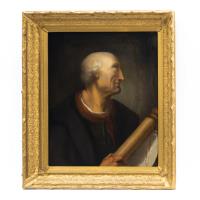O-273 • painting (portrait) • Amerigo Vespucci
Specifications
| Artists | Antoine Sébastien Falardeau (Artist) |
|---|---|
| Date | 1857 |
| Materials | paint, oil |
| Support | canvas |
| Personal Names | Amerigo Vespucci |
| Dimensions (cm) | 54.5 (Width) • 66.5 (Height) |
| Functions | Art |
| Barcode | 603894 |

Antoine Sébastien Falardeau
Antoine Sébastien Falardeau was born in 1822 near Cap-Santé, on the shore of the St. Lawrence River, in what was then called Lower Canada. Little is known about his training as an artist. As a young man, he moved from the family farm to Quebec City, where he worked for some time as a clerk and apprenticed as a sign painter. At the age of 24 he left for Italy, where he would make Florence his lifelong home. There, he established his artistic reputation and made a good living as a copyist. On a visit to Canada in 1862, he exhibited and sold many paintings. In 1882 he received a government commission of five hundred dollars to paint a portrait of former Quebec Premier Joseph-Adolphe Chapleau. Falardeau died in Florence in 1889.
The Musée national des beaux-arts du Québec has about 20 of Falardeau’s works in its collection.